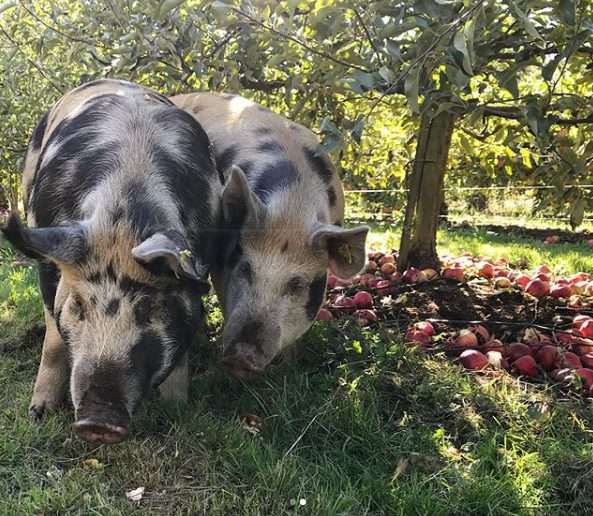We’re involved with a local campaign to re-wild as much as possible of our village as part of a larger community exercise to reduce CO₂, lower waste output and drop our energy consumption. The former includes such items as wild flower planting on (currently) grassed areas, setting aside other pieces of land for reverting to wild meadows, setting up a communal gardening area and even plans for a village orchard (which could allow us to make our own cider)…
It’s a small piece of agroforestry. Pigs love orchards. Orchards love pigs.
Before us humans managed to develop mechanised agricultural tools, our domestic pigs contributed valuable work for the farmer & smallholder helping them to prepare the land for crops. Pigs would assist the clearing of forested land by rooting and digging around and eating seeds, roots, and small growth. And when turned out in a newly harvested field, they’d consume any crop residues helping to discourage pests and diseases that lived in rotting fruits or vegetables. The pigs’ rooting would also then turn over the soil in preparation for the plantings next year.
 Pigs hoovering up excess apples © Kelsey-Smith
Pigs hoovering up excess apples © Kelsey-SmithIn Britain, using the pig this way meant that it was also a very effective weapon in the war against one of our poisonous weeds — the bracken fern. As early as 3000 BCE farmers have battled the bracken with pigs, as the weed would invade cleared land thus ruining these pastures for cattle, horses, and sheep. Pigs however will root through the soil, damaging the bracken roots, exposing the rhizomes and trampling & bruising the fronds, all actions which kept the weed on the retreat. Remember, this was was long before poisons such as glyphosate became available. And whilst bracken does contain small amounts of cyanide and other possibly carcinogenic elements which can leach out into ground-water, the effects of glyphosate on the entire environment and the proven huge damage to our long-term health (and that of the animals and rest of the eco-system we’re dependent on) are far, far more dangerous. Me? I’ll stick with the pigs & risk a little bracken. Monsanto and their ilk can fuck right off and die in a fire.
There are a couple of other interesting side-notes here: an English commoner was forbidden to use dogs for hunting for all the years between the eleventh and fifteenth centuries (that privilege being reserved to the rich), so hunters chose pigs instead when going into the woods. They’re excellent at scaring out any game concealed in the undergrowth even if they’re (usually) no actual danger to these other animals. Pigs are also experts at killing snakes (work that would later be greatly valued in the colonisation of the New World). And in France and Italy, pigs helped in the search for the valuable truffle, which can grow up to 12 inches under the soil surface. Over centuries, sows known as chercheurs, or ‘searchers’, proved themselves to be pin-point accurate locators of these little black treasures.
I don’t think we’ve (yet) got any truffles in the woods around here. We certainly don’t have any bracken. The adder is so rare as to be almost a non-existent threat and we have no plans whatsoever to go hunting for the few muntjac around here. That said, I have this day-dream of an orchard area, dappled in sunlight, bees & other pollinators, noisy and dense in the tree foliage, with pigs snuffling around the base of the trees, doing what they do so well. I may have to settle for something less contentious. Like a few humans doing the hard work. Or maybe a goat?
[Some useful detail informing this piece came from the invaluable “The Encyclopedia of Historic and Endangered Livestock and Poultry Breeds” by Janet Vorwald Dohner. A really scholarly work. Well worth finding a copy on AbeBooks or Alibris if you can.]